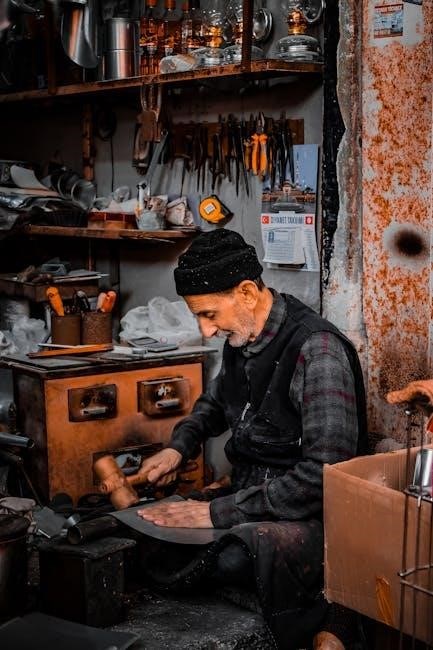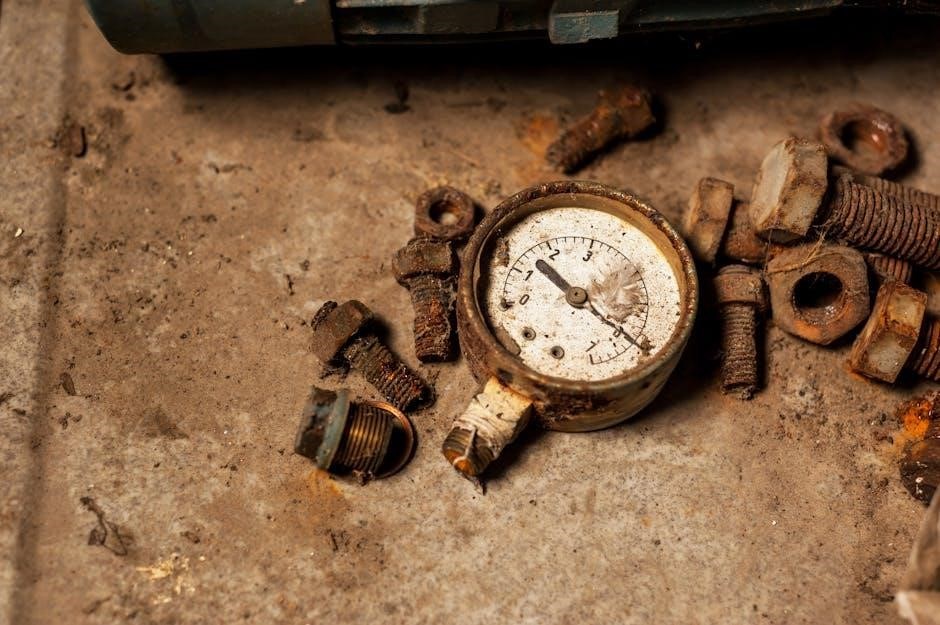Presto Pressure Canner and Cooker Manual: A Comprehensive Guide
Welcome! This guide is designed to help you safely and effectively use your Presto pressure canner and cooker. We will explore everything from initial setup and crucial safety precautions to detailed canning and cooking instructions.
Presto pressure canners and cookers are versatile kitchen appliances designed for both pressure canning and pressure cooking.
Pressure canning allows you to safely preserve low-acid foods like vegetables, meats, and seafood, preventing spoilage and ensuring long-term storage. Pressure cooking, on the other hand, offers a fast and efficient way to cook a variety of dishes, retaining more nutrients compared to traditional cooking methods.
Presto offers a range of models, including both stovetop and digital electric versions, each with specific features and capabilities. Understanding the differences between these models is crucial for selecting the right appliance for your needs.
The Presto Precise Digital Pressure Canner, for example, offers automated controls and is designed specifically for pressure canning low-acid foods. Stovetop models, like the Presto 23-Quart Aluminum Pressure Canner, offer a larger capacity and are compatible with various cooktops, excluding outdoor LP gas burners with high BTU output, as these can damage the canner.
Whether you are an experienced canner or new to pressure cooking, Presto canners and cookers provide a reliable solution for preserving food and preparing delicious meals.

Understanding the Manual: Key Sections and Features
The Presto pressure canner and cooker manual is structured to guide you through every aspect of using your appliance safely and effectively. Familiarizing yourself with its key sections and features is essential for optimal use.
The manual typically begins with important safeguards, highlighting crucial safety precautions to prevent injury or damage. This section covers warnings about using the canner on unsuitable heat sources and the importance of not touching hot surfaces.
Next, the “Getting Acquainted” section introduces the canner’s components and their functions. Understanding these parts is vital for proper assembly and operation.
The manual also includes a section on “Before First Use,” which outlines the necessary steps for preparing and inspecting the canner to ensure it is in good working condition.
Step-by-step instructions on “How to Use Your Canner” are provided for both pressure canning and pressure cooking. These instructions cover everything from filling the canner to monitoring pressure levels;
Other key sections include “Care and Maintenance” tips for cleaning and storing your canner, as well as “Troubleshooting” advice for resolving common issues.
Additionally, the manual offers various recipes and guidelines for canning different types of foods, including fruits, vegetables, meats, and seafood.
Important Safeguards and Safety Precautions
Operating a pressure canner and cooker involves inherent risks, making it paramount to adhere strictly to all safety precautions outlined in the manual. These safeguards are designed to minimize the potential for accidents, injuries, and property damage.
Firstly, always ensure the canner is used on a suitable heat source; Avoid outdoor LP gas burners or gas ranges exceeding 12,000 BTUs, as they can cause damage.
Secondly, exercise extreme caution when moving a canner containing hot liquids. Never touch hot surfaces directly; use handles or knobs.
Thirdly, regularly inspect the canner for any signs of damage, such as cracks, dents, or a worn sealing gasket. Replace any damaged parts immediately.
Fourthly, carefully follow the manual’s instructions for venting the canner to remove air before pressurizing. Failure to vent properly can lead to inaccurate pressure readings and potential hazards.
Fifthly, never attempt to open the canner while it is pressurized. Wait until the pressure has completely reduced and the air vent/cover lock has dropped.
Sixthly, always use the canning-cooking rack when canning to ensure proper heat distribution.
Finally, store the canner in a safe place away from children.
Getting Acquainted with Your Presto Canner/Cooker
Before embarking on your canning or cooking journey, it’s crucial to familiarize yourself with the various components of your Presto pressure canner/cooker. Understanding each part and its function will contribute to safe and efficient operation.
Firstly, identify the canner body, the large pot that holds the food and liquid. Note the markings indicating the maximum fill line.
Secondly, locate the cover, which seals the canner and maintains pressure. Examine the sealing gasket, ensuring it’s clean and properly seated.
Thirdly, find the air vent/cover lock, a crucial safety feature that prevents the canner from being opened while pressurized. Observe how it rises and falls with pressure changes.
Fourthly, identify the pressure regulator, which maintains the desired pressure level. Different models may have varying regulator designs.

Fifthly, locate the vent pipe, where the pressure regulator is placed. Ensure it’s clear of any obstructions.
Sixthly, familiarize yourself with the safety valve, an overpressure release mechanism.
Finally, locate the canning/cooking rack, which elevates jars or food above the water level. By understanding these components, you’ll be well-prepared for successful canning and cooking.

Before First Use: Preparation and Inspection
Prior to your initial canning or cooking endeavor, thorough preparation and inspection of your Presto pressure canner/cooker are paramount to ensure safe and optimal performance.
Firstly, meticulously wash the canner body, cover, and all removable components with warm, soapy water. Rinse thoroughly and dry completely. This removes any manufacturing residues or dust.
Secondly, carefully inspect the sealing gasket for any signs of cracks, tears, or deterioration. A damaged gasket can compromise the seal and prevent proper pressurization. If damaged, replace the gasket before use.
Thirdly, examine the air vent/cover lock for free movement. Ensure it rises and falls smoothly without any obstructions.
Fourthly, check the vent pipe for any blockages. Use a small brush or pipe cleaner to clear any debris that may be present.
Fifthly, if your model has a dial gauge, verify its accuracy. If unsure, consult the manual for instructions on testing or calibration, or contact Presto’s customer service.
Sixthly, perform a water test run. Fill the canner with the recommended amount of water, seal the lid, and bring it up to pressure following the manual’s instructions. This confirms proper sealing and pressure regulation. This ensures everything works correctly.
How to Use Your Presto Pressure Canner: A Step-by-Step Guide
Mastering the operation of your Presto pressure canner is essential for safe and successful home canning. These steps will guide you:
Step 1: Preparation. Ensure your jars, lids, and bands are clean and sterilized. Prepare your food according to a tested canning recipe.
Step 2: Water Level. Add the specified amount of water to the canner, typically 2 to 3 inches, as indicated in your recipe. Place the canning rack at the bottom.
Step 3: Jar Placement. Carefully load filled jars onto the rack, ensuring they don’t touch each other or the canner walls.
Step 4: Lid Closure. Securely fasten the canner lid, ensuring the gasket is properly seated. Align the lid and body handles as directed in your manual.
Step 5: Venting. Leave the vent pipe open. Heat the canner over medium-high heat until a steady stream of steam escapes for 10 minutes to exhaust air.
Step 6: Pressurization. Place the pressure regulator on the vent pipe. The canner will now pressurize.
Step 7: Processing. Once the desired pressure is reached, adjust the heat to maintain a steady pressure.
Step 8: Cooling. Turn off the heat and let the canner cool naturally until the pressure returns to zero.
Pressure Canning: Principles and Guidelines
Pressure canning is a crucial method for preserving low-acid foods, such as vegetables, meats, and poultry, ensuring their safety and longevity. Unlike boiling water canning, which is suitable for high-acid foods like fruits and tomatoes, pressure canning reaches higher temperatures necessary to eliminate the risk of botulism, a deadly form of food poisoning.
The core principle behind pressure canning is using steam under pressure to achieve temperatures of 240°F (116°C) or higher. This intense heat destroys harmful bacteria, including Clostridium botulinum spores, that can survive in low-acid environments.
Key Guidelines:
Acidity Matters: Only use pressure canning for low-acid foods.
Follow Recipes: Adhere strictly to tested recipes from reputable sources like the USDA or university extension services.

Proper Headspace: Leave the correct amount of headspace in jars to allow for expansion during processing.
Accurate Pressure: Maintain the recommended pressure throughout the canning process, adjusting for altitude if necessary.
Cooling Process: Allow the canner to cool naturally to avoid siphoning and jar breakage.
Jar Inspection: After cooling, check the jar seals to ensure proper preservation.
How to Pressure Can Foods Safely and Effectively
Safely and effectively pressure canning foods involves a meticulous process, ensuring both preservation and safety. Begin by thoroughly washing and preparing your chosen low-acid foods according to a tested recipe. Pack the food into clean, hot Mason jars, leaving the specified headspace. This space allows for expansion during processing and prevents jar breakage.
Next, add the appropriate amount of liquid, usually boiling water or broth, ensuring all food is covered. Remove any air bubbles by gently tapping the jars or using a non-metallic spatula. Wipe the jar rims clean to ensure a proper seal. Center the lids on the jars and apply the bands fingertip-tight.
Place the filled jars on the rack inside the pressure canner, adding the amount of water specified in your canner’s manual. Lock the canner lid securely, following the manufacturer’s instructions. Vent the canner by allowing steam to escape for the recommended time, usually 10 minutes, to remove air and ensure pure steam.
Then, close the vent and allow the pressure to build to the level specified in your recipe, adjusting for altitude. Maintain this pressure consistently throughout the processing time; Once processing is complete, turn off the heat and allow the canner to cool naturally until the pressure returns to zero. Carefully remove the jars and let them cool completely before checking the seals.
Care and Maintenance: Cleaning and Storage Tips
Proper care and maintenance are essential to prolong the life of your Presto pressure canner and cooker, ensuring safe and efficient operation; After each use, allow the canner to cool completely before cleaning. Wash the canner body and lid with hot, soapy water, using a non-abrasive sponge or cloth to prevent scratching the surface. Rinse thoroughly and dry completely.
Pay special attention to cleaning the vent pipe and overpressure plug, ensuring they are free from any food particles or debris that could obstruct their function. Use a small brush or pipe cleaner to clear the vent pipe, and inspect the overpressure plug for any signs of wear or damage.
The sealing gasket should also be cleaned and inspected regularly. Remove the gasket from the lid and wash it with warm, soapy water. Avoid using harsh detergents or abrasive cleaners that could damage the rubber. Allow the gasket to air dry completely before reassembling it. Store the canner in a cool, dry place, away from direct sunlight or extreme temperatures.
To prevent the lid from sealing shut during storage, place a rolled-up towel or piece of paper between the lid and the canner body. This will allow air to circulate and prevent the gasket from sticking. Regularly inspect all parts of the canner for any signs of damage or wear, and replace them as needed to ensure safe and reliable performance.
Troubleshooting Common Issues and Solutions
Encountering issues with your Presto pressure canner and cooker can be frustrating, but many problems have simple solutions. If the canner fails to reach the desired pressure, ensure the sealing gasket is properly seated and in good condition. Check that the vent pipe is clear of obstructions and that the heat source is adequate. Insufficient liquid in the canner can also prevent pressure buildup.
If steam is leaking from around the lid, the gasket may be damaged or improperly installed. Inspect the lid for dents or warping that could compromise the seal. Uneven heating can also cause pressure fluctuations. Ensure the canner is centered on the burner.
If the pressure regulator is not rocking gently, the heat may be too low, or the gauge may be inaccurate. If food is scorching, reduce the heat and ensure there is enough liquid in the canner;
If the air vent/cover lock is not dropping after cooling, there may still be residual pressure inside. Allow more time for cooling, or carefully run cold water over the lid. Never force the lid open while pressure remains. If problems persist, consult the Presto website or contact customer service for further assistance. Always prioritize safety when troubleshooting.
Pressure Cooking with Your Presto Canner/Cooker
Beyond its canning capabilities, your Presto pressure canner doubles as an efficient pressure cooker. Pressure cooking significantly reduces cooking times while preserving nutrients and flavors. To pressure cook, add the appropriate amount of liquid (usually water or broth) as specified in your recipe. Place the food in the canner, ensuring it doesn’t exceed the maximum fill line.
Secure the lid, following the same procedures as for canning, and bring the canner to the desired pressure. Once the pressure regulator begins to rock, reduce the heat to maintain a gentle rocking motion. Cooking times vary depending on the food type and quantity, so consult a reliable pressure cooking resource.
After the cooking time is complete, allow the pressure to release naturally or use the quick-release method (if recommended for your model and recipe). Always ensure all pressure is fully released before opening the lid. Pressure cooking is ideal for tenderizing tough cuts of meat, preparing hearty soups and stews, and cooking grains and beans quickly. Remember to adjust cooking times based on altitude, as higher altitudes require longer cooking durations. Explore the versatility of your Presto canner/cooker with a variety of delicious and time-saving recipes.
Finding Manuals and Replacement Parts
Losing your Presto pressure canner and cooker manual can be frustrating, but don’t worry, resources are readily available. Start by visiting the official Presto website; they often have a digital library of manuals available for download, searchable by model number. This is the quickest and most reliable way to find the exact manual for your specific canner.
If you’re unable to locate it on the official site, try searching online using the model number and keywords like “Presto pressure canner manual PDF.” Many third-party websites offer downloadable manuals, but exercise caution and ensure the source is reputable to avoid downloading potentially harmful files.
For replacement parts, such as sealing rings, pressure regulators, and safety valves, check the Presto website or authorized retailers. Many hardware stores and kitchen supply stores also carry Presto parts. When ordering, always specify the model number of your canner to ensure you receive the correct components. Regular inspection and replacement of worn parts are crucial for safe and effective operation. Consider keeping a spare sealing ring on hand, as it’s the most frequently replaced part.
